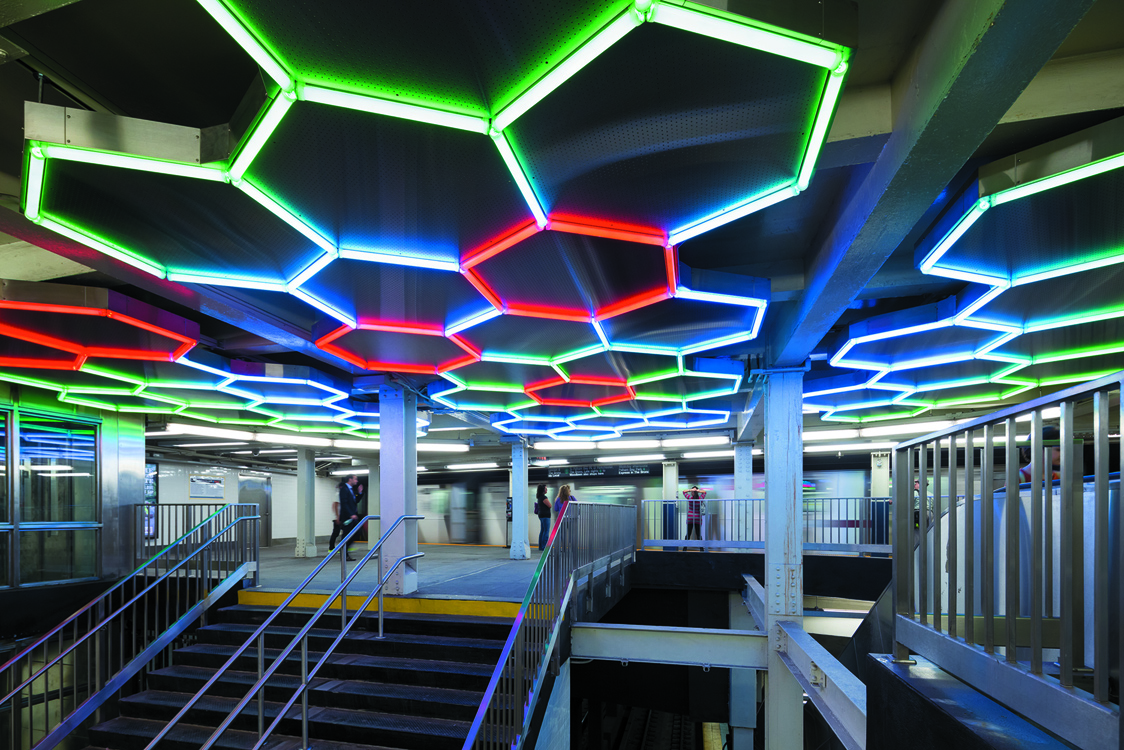by: jchristie
For me, it’s Nancy Spero’s Lincoln Center mosaics, Artemis, Acrobats, Divas and Dancers. I pass them nearly every day on the 1/2/3 line, and I always peer out the train window to look. Transit art is simultaneously hugely public and deeply intimate; the majority of the 4.3 million daily riders of the New York City rail system see the same works of art every day on their commute. “It’s a museum, with hundreds of miles of walls; it’s a museum that never closes; it’s a museum with a fairly modest entry fee,” praised Sam Roberts, New York Times Urban Affairs correspondent. The MTA’s Percent for Art Program, which dedicates 1% of the cost of city-funded construction projects to public art, has repurposed the many walls of our underground streets into a living museum. The program was instituted in 1982 by Mayor Edward Koch and pushed by Ronay Menschel, founder of MTA Arts & Design, at a time of a reinvestment in the city’s public transit. Since its inception, MTA Arts & Design has commissioned 260 works of public art. On 02.19. 15, director of MTA Arts & Design Sandra Bloodworth, artist Andrea Dezso, Sam Roberts, and Ronay Menschel, former MTA board member, gathered at the Museum of the City of New York to talk about the history and vision of MTA Arts and the Percent for Arts Program.
MTA Arts for Transit vets projects that reflect “the ridership…the people using the system,” said Bloodworth. The diversity of artists commissioned for projects is a point of pride for Bloodworth and her team; though they have not yet finalized their statistics, the program represents a considerable number of women, artists of color, and not-yet established artists, alongside art stars like Sol LeWitt. As an audience member pointed out, MTA Arts is not a collector but a commissioner of art, which grants a particular power to enact the social change they want to see. If not an artist from the community the station is based in, the program strives to have a selection panelist from that community. Andrea Deszo, the artist behind Bedford Park Station’s Community Garden mosaic, described how she approached her first public, site-specific work: “Why this in this neighborhood? Why would people want to look at it?” She noticed that the Northwest Bronx neighborhood was a “very urban, very grey, very brown neighborhood, with lots of children and immigrants.” She “didn’t feel they had a lot of access to nature or color, and [wanted to] bring something that was missing: color, nature, uplift, and imagination.”
Speaking to the history of the program, Menschel pointed to the beautiful, open architecture by quoting the 1902 commissioner of New York’s Rapid Transit Railroad, when he said that all subway stations in the city were to be “designed, constructed, and maintained with a view to the beauty of their appearance, as well as to their efficiency.” Menschel also called attention to the icons of the original IRT system, such as the beavers of the Astor Place 4/5/6 Station (the Astor fortune started with fur trading). These icons acted as placemakers, particularly in communities of non-English speaking immigrants. Art in the transit system continues to not solely inspire commuters or brighten our underground surroundings, but perform a key role in placemaking. Fulton Center, the newest and boldest example of this practice, captures the intersection of art, public architecture, and infrastructure. As also evident in the new Fulton Center, MTA Arts is not shying away from digital art. No longer needing to cross paths with a particular station, commuters and art lovers can check on their favorite installations and discover new ones via any digital pathway on The MTA Arts & Design App, or purchase the newly published New York’s Underground Art Museum: MTA Arts for Transit in print.
Event: New York’s Underground Art Museum – MTA Arts & Design
Location: Museum of the City of New York, 02.19.15
Speakers: Sandra Bloodworth, Author and Director, MTA Arts & Design; Sam Roberts, Urban Affairs Correspondent, The New York Times; Andrea Dezso, Visual Artist; and Ronay Menschel, former MTA Board Member, and Founder, MTA Arts & Design
Organizers: The Museum of the City of New York
Co-sponsors: Center for Architecture











